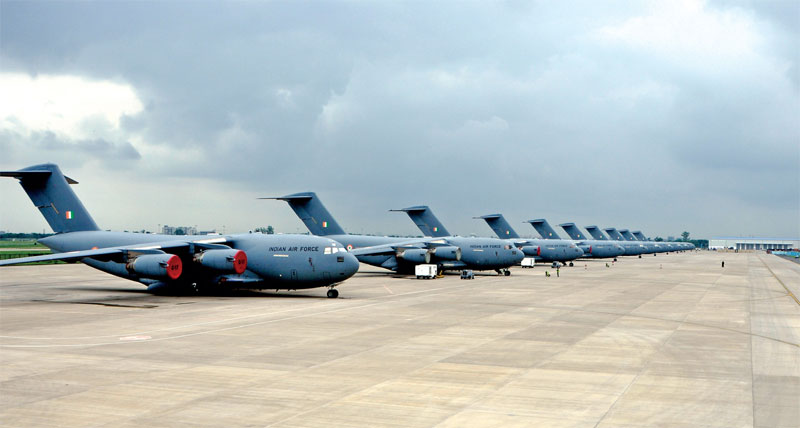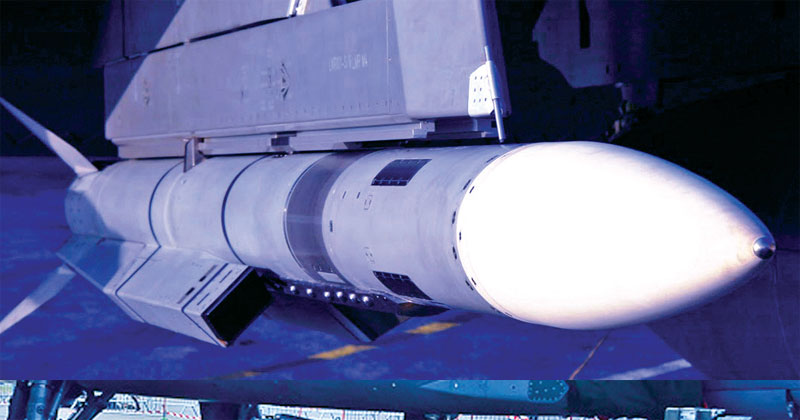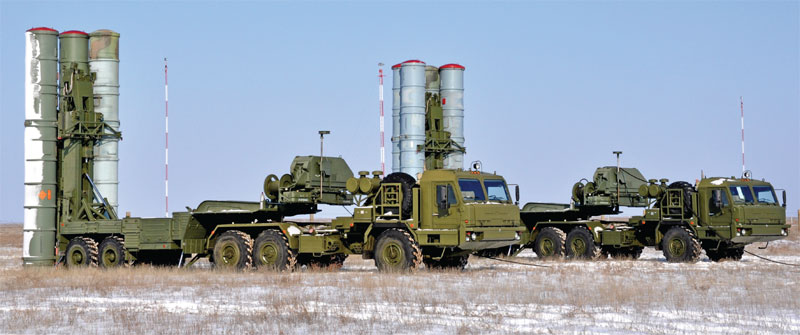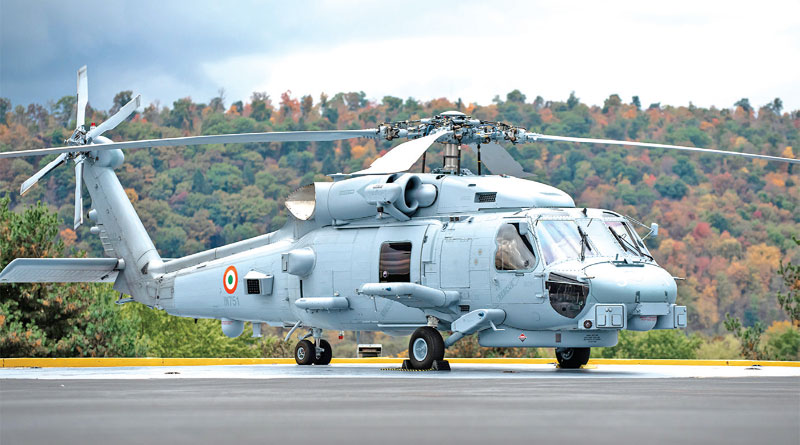Despite efforts at self-reliance, India will continue to depend on imports of critical arms
Smruti Deshpande
A couple of years back defence minister Rajnath Singh said that a country that depended on military imports could never be strong, adding that being self-sufficient in the defence sector was linked to ‘self-respect’ and ‘sovereignty.’

While India is actively publicising its intention towards becoming Aatmanirbhar, or self-reliant in defence, the country still relies heavily on foreign equipment. India continues depending on different countries for key technologies such as missiles, fighter jets, tanks, UAVs as well as engines. Even as efforts are being made by the local industry to step up manufacturing, India remains one of the largest importers of defence platforms.
A Stockholm International Peace Research Institute (SIPRI) report from 2022 stated that India accounts for 11 per cent of the global arms imports. Russia remains India’s largest defence partner, although this is slowly changing with India’s imports from France and the US increasing considerably over the past few years.
From Russian Shores
After Russia attacked Ukraine, India’s arms dependence on Russia became the focus of debate within the country and abroad. The three Indian service chiefs were faced with the question of how western sanctions on Russia would hamper India’s military preparedness. Experts mulled the impact on India, spoke of possible shortages as well as alternatives India could consider. The Indian defence manufacturing industry was brought into the limelight and Aatmanirbharta was deemed as a solution. The US saw an opportunity to wean India away from Russia and promoted its defence industry.
While India is turning towards the West, it is not yet possible to completely shut Russia out when it comes to procurements. India’s military relations with Russia will continue because of the country’s lack of investment in Maintenance Repair and Overhaul (MRO) facilities. While the Indian Air Force’s (IAF) in-house MROs have been equipped to maintain fleets of rotorcraft and fixed-wing aircraft, it is not possible for the force to cater to every aircraft present in the force. India and Russia have signed pacts to maintain some of the Russian-origin military equipment within the country.
For instance, in 2017, the two countries signed two key agreements for long-term maintenance and technical support for Russian-made Su-30MKI fighter jets of the IAF. The pacts were signed between India’s Hindustan Aeronautics Limited (HAL) and two Russian companies in the presence of the then defence minister Arun Jaitley and Russia’s industry and trade minister Denis Manturov. In November 2022, The Hindu reported that the single squadron of Mi-35 attack helicopters in the IAF were undergoing a complete overhaul in Russia to extend the lifespan of these helicopter by six years. The overhaul is being undertaken in two batches and it should be completed by mid-2023.
Similarly in 2019, the Mi-26 helicopters were also required to fly back to Russia for overhaul. The IAF operated two squadrons of the older Russian Mi-25/35 attack helicopters, of which one squadron has been phased out following the induction of 22 Boeing AH-64E Apache attack helicopters in 2019-20. Of the 500 helicopters that the IAF operates, 90 are Mi-17s, 130 are Mi17 Vs and the one squadron of Mi-35 attack helicopters, all of which are of Russian origin. India also operates Mi-26 heavy-lift helicopters and Kamov anti-submarine warfare helicopters. The rest include Advanced Light Helicopters (ALH), including the Rudra variant, AH-64E Apache attack helicopters and CH-47F Chinook heavy lift helicopters.

Despite the local industry having stepped up, India continues to depend heavily on Russian spares. In addition, Russia is the only country willing to share some of its most advanced technologies with India. The procurement of the S-400 missile defence system is one example. India signed a deal of nearly 5.5 billion USD for five squadrons of S-400 missile defence systems. India started receiving its delivery in December 2021. While India awaits the delivery of the third squadron, the first two have been deployed in the Ladakh sector.
Russia is the only country to help India indigenously develop nuclear-powered submarines. A study by Stimson Centre in July 2020 said 86 per cent of Indian military equipment were of Russian origin and that the dependence was likely to continue because more than 55 per cent of the Indian defence imports since 2014 had been from Russia. The country is the world’s second-largest arms exporter, which accounts for 20 per cent of global weapons sales. As per an Al Jazeera report, Moscow exports nearly 90 per cent of its arms to 10 countries. Its biggest customer, India, bought 23 per cent of Russia’s weapons for some USD 6.5 billion over the past five years. Half of India’s total arms imports, 49.3 per cent, come from Russia.
According to data by the Observer Research Foundation, in the decade between 2011 and 2021 Russia made USD 22.8 billion worth of arms transfers to India, which was 42.5 per cent higher than the previous decade. Aircraft make up 48.6 per cent of Russian arms exports and while it exported 400 fighter jets, including the Sukhois and MiGs to not less than 13 countries, India bought at least half of them. India recently concluded a deal worth USD 677 million with Russia for the manufacturing of the AK-203 rifles within the country. A joint venture company, the Indo-Russian Rifles Private Ltd at Korwa, Amethi, will produce six lakh rifles. The BrahMos missile system is another important example of India-Russia cooperation.

An analysis by the Institut Montaigne suggests that the Su-30 MKI fighters constitute 14 of the IAF’s 30 squadrons. Around 70 per cent of the equipment of the IAF are of Russian origin. Among the Russian aircraft with the IAF are MiG-29UPG, MiG-21, IL-78 tankers, IL-76 aircraft that now carry Airborne Warning and Control Systems that India procured from Israel. Interestingly, the paper also says that ‘while India has for decades attempted to develop a military industry of its own, Russia has assisted the country more than any other in this direction. For example, it has helped build factories to assemble licenced MiG-21 and MiG-23/27 fighters, as well as to repair T-72 tanks. Comparatively, Russia has been more open than the West to the transfer of technologies in the framework of joint ventures.’
The Indian Navy is also an operator of Russian platforms. The navy, according to Institut Montaigne, has 40 per cent of Russian equipment in its inventory, the lowest of the three armed forces. One of the major additions into the navy was INS Vikramaditya, which was bought in 2004 after Russia decommissioned it. The vessel was originally operated by the Soviet navy. In addition to that, major ships such as the Rajput-class destroyers, Talwar-class frigates, and Veer-class missile corvettes have also been of Russian origin. India’s eight kilo-class submarines also come from Russia. In 2019 India signed a pact with Russia for Chakra-3 attack submarines. According to SIPRI, Russia has pending deliveries to India, which include air defence systems, frigates and a nuclear-powered submarine. Naval nuclear propulsion is also one key technology that India imports from Russia. Admiral Grigorovich-class guided-missile frigates are among the ones yet to be delivered.
In one of its reports FORCE had said the army awaits 464 Russian T-90MS main battle tanks (MBTs), an undisclosed number of 2S25 Sprut-SD light tanks and 12 Su-30MKIs—to be licence-built locally—besides several other items. Different data suggests that nearly 90 to 95 per cent of the army’s 3,000 MBTs operated by around 67 armoured regiments were imported from Russia and licence-built in India. Russian T-72M1 and T-90S tank variants and the 2,000-odd infantry combat vehicles—the BMP 1& 2 — were similarly procured. The Konkurs Anti-Tank-Guided-Missiles (ATGM), Korent ATGM, OSA surface-to-air missile, Pechora surface-to-air missile, Strela surface-to-air missile and the Igla are Russian. So also are the Smerch and Grad multiple rocket launcher systems in use with the army. The R-77, R-37, the R-73 air-to-air missiles, the Kh-59, Kh-35, the Kh-31 air-to-surface missiles, the KAB laser-guided bombs are operated from the Su-30 MKI.

The US Inroads
A report published by SIPRI in May 2022 stated that India had bought USD 4 billion worth of military equipment from the US and more than 25 billion worth from Russia in the past decade. The US is India’s second largest arms exporter, and the three services use several platforms bought from the US. In a bid to gain advantage over Russia, especially after the conflict between Russia and Ukraine, the US has actively begun weaning India away from Russia by offering USD 500 million as military financing. If India accepts such aid, it would be following Egypt and Israel.
In October 2022, Rajnath Singh during a seminar by the US-India Business Council invited US defence companies to carry out joint R&D and manufacturing in India to create a global supply chain ‘free from vulnerabilities and uncertainties.’ India is leaning towards the West for arms procurements. According to data released by the Defence Security Cooperation Agency (DSCA), a part of the US Department of Defence (DoD), India’s weapons procurement from the US jumped from a meagre USD 6.2 million to a whopping USD 3.4 billion in the final year of Donald Trump’s administration. The 2020 edition of the Historical Sales Book records that India purchased weapons worth USD 754.4 million in 2017 and USD 282 million in 2018. Between 1950 and 2020, US sale of weapons to India under Foreign Military Sales (FMS) category was USD 12.8 billion. According to the SIPRI, Russia’s share of the Indian market fell to 58 percent from 76 per cent in 2013-2018. In this period, the US held the second place as arms supplier to India.
In recent times India has bought platforms worth billions of dollars from the US. In December last year, the Indian Navy reinitiated the programme to buy six Boeing P8I Long Range Maritime Reconnaissance (LRMR) aircraft under a multi-billion-dollar government-to-government deal, which stalled after the expiry of the price offer on 31 July 2022, as reported by BusinessWorld. The Indian Navy operates 12 P8Is of which eight are based at the naval air base INS Rajali in Arakonam on the Eastern Seaboard and four at INS Hansa in Goa on the West. The navy also operates six MH-60 R multirole helicopters that were bought as a part of the Foreign Military Sales (FMS) government-to-government deal. The delivery of all 24 of these helicopters will be completed by 2025.
The IAF awarded USD 328.8 million contract to Lockheed Martin in 2021 to provide comprehensive support for the IAF’s 12 C-130J Super Hercules. India first placed the order for six airlifters in 2008. These were delivered between 2010-2011. Additional ones were received in 2017 and 2019. India already operates about 15 Chinook helicopters procured from Boeing. The Hindu reported that India might buy 11 more Chinooks. The IAF operates 22 AH-64 E Apache helicopters while six are being procured by the army. There is a possibility that the army will buy more of these helicopters. Apart from Apaches and Chinooks, the IAF also operates C17 Globemasters. Three VVIP aircraft and two head of state aircraft are also in service in India.
Boeing is offering its F/A18 Super Hornet Block III for the Indian Navy. The company is also competing for the IAF’s fighter jet race. Boeing has fielded the F15 EX and F/A-18 Super Hornet jets for the IAF’s Multirole Fighter Aircraft (MRFA) programme. But the programme has been stuck for a long time. The F/A18 Super Hornet competed with the French Rafale-M for the Indian Navy’s twin engine deck-based fighters. Rafale-M seems to have edged the Super Hornet out and India will sign a deal with France in the coming months. Boeing has invested in the Boeing India Repair Development and Sustainment (BIRDS) programme in order to help develop India into a regional MRO hub.
In addition, India awaits the procurement of 30 MQ-9 Predator/Reaper drones from General Atomics, 10 each for the three services, all of which will cost the exchequer 3 billion USD. ISTAR (Intelligence, Surveillance, Target Acquisition and Reconnaissance), an aircraft that tracks mobile ground targets, maps natural disaster areas and monitors ships and activities near the borders and littoral regions, can be used with a fixed or mobile station to perform command and control operations. During his address on the 90th Air Force Day last October, Chief of Air Staff Air Chief Marshal V R Chaudhuri confirmed the force’s intention to buy this aircraft. The five ISTAR aircraft that India is planning to get from the US is expected to cost 3 billion USD approximately.

European Market
India has a variety of weapon systems in its inventory, procured or jointly manufactured with different OEMs around the world. While France ranks number one on India’s list of countries to procure defence platforms from among the European countries, several other countries and conglomerates are not far behind. The United Kingdom, for instance, according to a CNBC report, has pledged to help India build its advanced fighter jets. In a first for an Asian country, the UK said it would issue an open general export licence to India.
Recently, India’s Garden Reach Shipbuilders and Engineers (GRSE) has partnered with Rolls Royce for building marine engines in India. GRSE and Rolls Royce Solutions will cooperate to manufacture under licence the technologically advanced MTU S4000 marine engines. The Kolkata-based GRSE signed a memorandum of understanding (MoU) with Rolls Royce Solutions of Germany to locally manufacture the latter’s marine diesel engines. Rolls Royce has been a long-standing partner of India’s. Several Indian military aircraft today are powered by the over 750 Rolls-Royce engines of 10 engine types, and are soaring the skies, including combat and strike aircraft, trainers, strategic airlift, VVIP and surveillance aircraft. According to a Financial Express report in October 2022, Rolls Royce is in talks with the DRDO to rev up AMCA engines. The report stated, “India is in talks with Rolls-Royce, French company Safran, which powers the Rafale fighter, and American company GE, which powers the Light Combat Aircraft Tejas, over a prospective agreement to manufacture a jet engine in India.”

MBDA, a European missile systems manufacturer, is a key player in arming Indian forces. India’s Rafale fighters are armed with the MBDA’s Meteor beyond visual range air-to-air missile, MICA air combat missile and SCALP deep strike missile. MBDA is also cooperating with Bharat Dynamics Ltd for the final assembly, integration and testing (FAIT) of ASRAAM and Mistral missiles for the air force. The navy’s Kalvari-class submarine is armed with the MBDA’s SM39 Exocet submarine-launched anti-ship missiles. The Army used the MILAN anti-tank guided missile designed by MBDA and built in India. ASRAAM missiles will also add to the air force’s power. MBDA will deliver the ASRAAM as the New Generation Close Combat Missile programme, to arm the IAF’s upgraded Jaguar fleet and Tejas LCA M1A.
While India is looking inwards for defence manufacturing, the local industry has a long way to go because of its limited R&D and manufacturing capability. This means there will still be dependence on foreign OEMs. For the Indian industry to truly march on, the best ingredient is entering into joint ventures.

